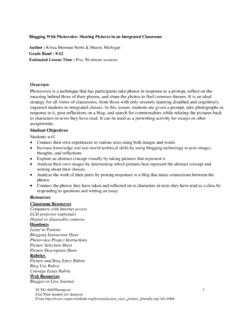Transcription of CHAPTER 07 SELF-PRESENTATION - University of …
1 February 19, 2013 at 9:44 PM page 1 of 42 C HAP T E R 07 S E LF-P RE S E NT A T I ON I. THE NATURE OF SELF-PRESENTATION .. 3 A. WHY DO PEOPLE ENGAGE IN SELF-PRESENTATION ? .. 3 B. WHEN AND HOW DO PEOPLE MANAGE IMPRESSIONS? .. 5 C. INDIVIDUAL DIFFERENCES IN SELF-PRESENTATION .. 7 II. CREATING DESIRED IMPRESSIONS .. 11 A. WHAT IMPRESSIONS DO PEOPLE TRY TO CREATE? .. 11 B. WHAT CONSTITUTES A DESIRABLE IMPRESSION? .. 13 C. IDENTITY PREDICAMENTS .. 17 D. IDENTITY-REPAIR TACTICS .. 20 III. self -PRESENTATIONS AND PRIVATE self -CONCEPTIONS .. 20 A. ROLE INTERNALIZATION.
2 21 B. CARRY-OVER EFFECTS IN SELF-PRESENTATION .. 22 C. SYMBOLIC self -COMPLETION THEORY .. 24 IV. SELF-PRESENTATION AND SOCIAL BEHAVIOR .. 26 A. SELF-PRESENTATION AND 26 B. SINCERITY AND AUTHENTICITY VERSUS PRETENSE AND DECEIT .. 30 V. CHAPTER SUMMARY .. 32 February 19, 2013 at 9:44 PM page 2 of 42 C HAP T E R 07 S E LF-P RE S E NT A T I ON There will be time, there will be time, to prepare a face to meet the faces that you meet. Eliot, The Lovesong of J. Alfred Prufrock The self -concept seems like a very private phenomenon. After all, people s thoughts about themselves are hidden and are often highly personal.
3 Yet the self -concept is also very much a social phenomenon. It has social roots ( , reflected appraisals, social comparison), it includes social identities and roles, and it guides our perception of others and our behavior in social settings. In this CHAPTER we will explore the social side of the self in the context of self -presentational behavior. self -presentational behavior is any behavior intended to create, modify, or maintain an impression of ourselves in the minds of According to this definition, whenever we are attempting to lead people to think of us in a particular way, we are engaging in SELF-PRESENTATION .
4 Because much of our time is spent in the company of other people, SELF-PRESENTATION is a pervasive feature of social life. We even engage in SELF-PRESENTATION when we are alone; for example, we rehearse what we are going to say or do in public, molding our behavior to an imaginary or anticipated audience. Sometimes this rehearsal is deliberate and noticeable (as when we prepare for a job interview or a public speaking engagement); other times it is automatic and almost imperceptible (as when we mindlessly check our hair in the mirror before stepping out the front door).
5 SELF-PRESENTATION is not only a prevalent aspect of our lives, it is also a very important one. Our success at leading others to believe we possess various characteristics has a profound influence on our outcomes in life (Hogan & Briggs, 1986). Who we marry, who our friends are, whether we get ahead at work, and many other outcomes depend, to a great extent, on our ability to convince people that we are worthy of their love, their friendship, their trust, and their respect. Undoubtedly, this need to create a positive impression is one reason that people spend billions of dollars a year on cosmetics and other personal-appearance products.
6 self -presentational concerns also lead people to engage in behaviors that enhance their appearance to others but simultaneously jeopardize their own physical well-being ( , overexposure to the sun; excessive dieting) (Leary, Tchividijian, & Kraxberger, 1994). self -presentational concerns can even underlie self -destructive behaviors, such as cigarette smoking and substance abuse (Sharp & Getz, 1996). The CHAPTER begins by considering the nature of self -presentational behavior. Why do people engage in SELF-PRESENTATION , and when and how do they go about creating impressions of themselves in the minds of other people?
7 In the second section of the 1 The term impression management has also been used to describe people s efforts to manage the impressions others form of them. Although the two terms ( SELF-PRESENTATION and impression management) differ in certain respects (see schlenker , 1980), I use them interchangeably throughout this CHAPTER . February 19, 2013 at 9:44 PM page 3 of 42 CHAPTER , we will look at the kinds of images people create and the obstacles they face when trying to create these images.
8 Here, we will also examine some of the things people do when they fail to make a desired impression. The third part of the CHAPTER explores the close connection between public behavior and private self -conceptions. We will see that people are very often audiences for their own behavior, and in the course of trying to convince others that they possess particular qualities, they end up convincing themselves. Finally, we will consider the extent to which public behavior is a faithful reflection of what people really think about themselves.
9 I. The Nature of SELF-PRESENTATION A. Why Do People Engage in SELF-PRESENTATION ? We begin our discussion by considering why people engage in SELF-PRESENTATION . Why do we bother to lead people to see us in one way or another? 1. Facilitate Social Interaction The most basic function of SELF-PRESENTATION is to define the nature of a social situation (Goffman, 1959). Most social interactions are very role governed. Each person has a role to play, and the interaction proceeds smoothly when these roles are enacted effectively.
10 For example, airline pilots are expected to be poised and dignified. As long as they convince their passengers that they possess these qualities, their passengers remain calm and behave in an orderly fashion. (Imagine, for example, how unsettling it would be if your airline pilot acted like the character Kramer on the television show Seinfeld!) This function of SELF-PRESENTATION was first highlighted by Erving Goffman (1959). Goffman noted that social life is highly structured. In some cases, this structure is formalized ( , state dinners at the White House are characterized by strict rules of protocol), but most often it is informal and tacitly understood ( , norms of politeness and etiquette guide our social interactions).












